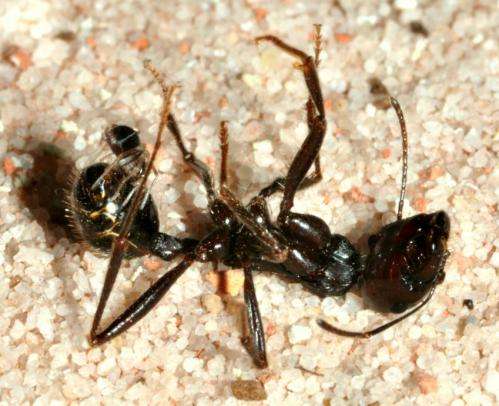David and Goliath: How a tiny spider catches much larger prey

In nature, it is very rare to find a proverbial much smaller David able to overpower and kill a Goliath for supper. This is exactly the modus operandi of a solitary tiny spider from the Negev desert in Israel that routinely kills ants up to almost four times its own size. Details about how it attacks and kills its prey with a venomous bite is published in Springer's journal Naturwissenschaften – The Science of Nature. The study was led by Stano Pekár of Masaryk University in the Czech Republic.
Pekár's team observed the natural prey and predatory behavior of the minute ant-eating Zodarion cyrenaicum spider in the field and in the laboratory. This spider feeds almost exclusively on the Messor arenarius ant. It can grow up to 17 millimeters and is therefore practically a giant compared to a spiderling of up to three millimetres in size. Two versions or morphs of this ant - a larger and a smaller one - are found.
Surprisingly, it was found that the spider, already at the juvenile stage, deliberately chooses to hunt Messor arenarius above all other ant species present in the sand dunes. This is in contrast to other Zodarion species where juveniles select small ants that are comparable to their own size and, as they develop, switch to larger ant species. The researchers suggest that this active selection is likely because the spider is able to recognize a specific component of a pheromone, a chemical substance, produced by the ant. Pekár's team also found that the adult female spiders generally capture the large morphs, while the tiny juvenile spiders catch smaller ants. In all cases, though, the spiders were much smaller than their prey. The giant ants were always captured by a single individual, and immobilized with a single bite.
Previous work done by Pekár showed that the capture strategy of female adult spiders includes a fast attack from behind, followed by a retreat to avoid counter-attacks by the ants. In the present study, he noted that the tiny juveniles' attack strategy differs from that of the females. Thanks to their tiny size, they are able to climb on the dorsal side of an ant and deliver an immobilizing bite to the abdomen, thus avoiding retaliation by the immediately helpless prey.
The venom glands of adult ant-eating spiders are more than 50 times larger than those of the juveniles. However, it only takes about twice as long for the venom of the younger spiders to take effect. This suggests that this spider species possesses very potent venom already at the juvenile stage. The greater success of adult spiders in capturing prey is most likely because they are able to inject more venom into their prey.
"Specialized capture combined with very effective venom enables this ant-eating spider to capture giant prey," Pekár concludes.
More information: Pekár, S. et al (2014). David and Goliath: potent venom of an ant-eating spider (Araneae) enables capture of a giant prey, Naturwissenschaften – The Science of Nature. DOI: 10.1007/s00114-014-1189-8
Provided by Springer





















